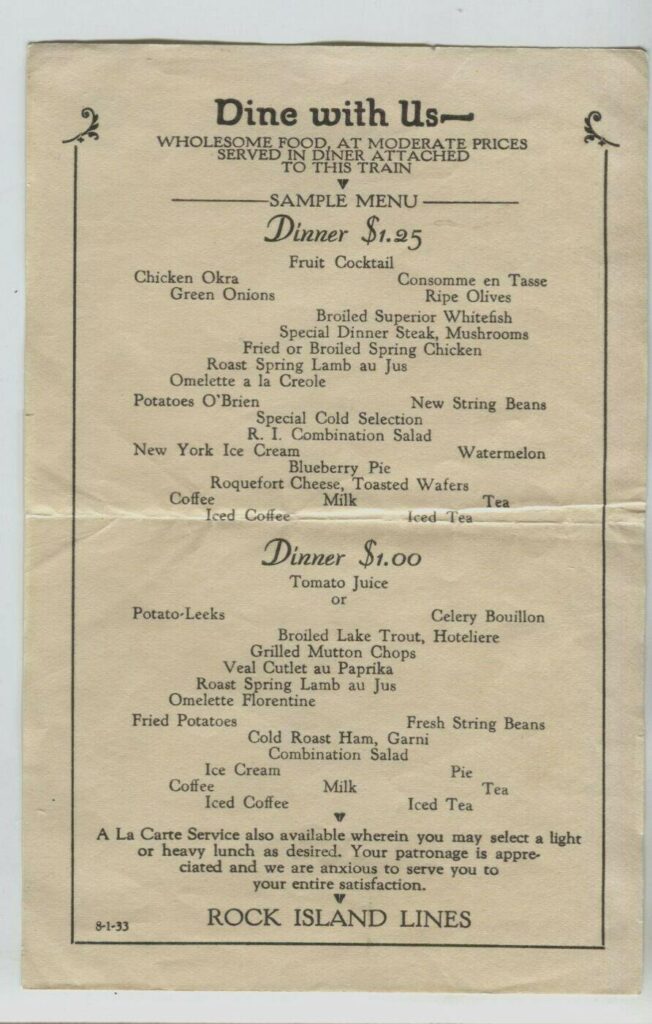For the last month of spring (and what a rainy one it has been!) we thought we’d feature a good comfort food—roast spring lamb with mint sauce—and the story of the Sheep and Cattle Wars. This staple dish was offered across many railroad lines, including this Union Pacific recipe that we will share below.
Before we dive into the Sheep and Cattle Wars, let’s talk about the history of spring lamb itself. The consumption of spring lamb goes back thousands of years, through various pastoral cultures through Europe, Asia, and Africa. In fact, sheep were first domesticated over 10,000 years ago in the Fertile Crescent, an area of land that encompassed many countries in the modern day Middle East. Eating lamb transcended many cultures, and was tied to various religious beliefs including Islam, Judaism, and Christianity. Lambs have long been seen as symbols for rebirth and renewal, perfect spring representations.
The history of sheep in North America goes back to the 1600s. The Spanish brought sheep to the Americas in the late 15th century, where over time they developed a large presence in the American West. Sheep, along with cattle and other livestock, were frequently transported by rail. Though sheep were in the West long before Anglo settlers arrived, there was a massive conflict between cattle ranchers and sheepherders between 1885 and 1934, known as the Sheep and Cattle Wars.
The fight between the two groups was mostly an issue of land. Both cattle and sheep needed land for grazing and as both groups attempted to settle on the land, the cattlemen in particular saw the shepherds as imposing on their land and taking the resources. Thousands of sheep and an unknown number of shepherds were killed by the cattlemen. More than just a conflict over land resources, the cattlemen were frequently white settlers while the shepherds were often Hispanic, and those racial tensions played a large role in the violence. The conflict was addressed in 1934 with the passage of the Taylor Grazing Act, in which a committee of both cattlemen and shepherds were appointed to determine grazing boundaries of the land.

Figure 3 Depiction of a sheep raid in Colorado during the Sheep and Cattle Wars, which lasted from 1885-1934.
Serving roasted spring lamb was ubiquitous across American railroads. Many railroads offered the dish including the Atchison, Topeka & Santa Fe, Union Pacific, and Chicago, Rock Island & Pacific. A popular sauce to serve with roasted lamb is mint sauce. Serving mint with lamb came from England, originally intended as a way to mask the gaminess of the lamb, and the combination ensues to this day.
Both the roast spring lamb recipe and the mint sauce come from the Union Pacific Dining Car Cook Book and Service Instructions. As always, please let us know if you try the recipes on our Facebook, Twitter, Instagram, or in the comments below! Enjoy!
Roast Spring Lamb
When featured on menu, prepare by boning shoulder, leg and sawing chine bone from lamb rack. Shoulder and leg to be rolled and tied securely and roasted in the same manner as Leg of Lamb. Place in roast pan with a bouquet of sliced vegetables, i.e., onions, carrots, celery and parsley stems. Season with salt and pepper and rub…with lard before placing in roast pan. Roast in fast oven for a few minutes with the bones and trimmings from the lamb. Reduce the heat and finish cooking. Never roast well done. Baste frequently during the roasting. Make a natural gravy from the pan trimmings and bones by adding rich stock to pan and season with salt, pepper and 1 tablespoon of Worcestershire sauce. Strain through a cloth and skim carefully. When serving, each portion should consist of one slice of leg, one slice of shoulder, cut ¼ inch thick and 1 rib from rack.
Garnish: Serve only the natural unthickened gravy with lamb. Mint sauce, Mint or Currant Jelly or sauce listed on menu to accompany.
Mint Sauce
2 cups of water, and 1 cup of cider vinegar, 2 cups of sugar, bring to a boil with stems from the fresh mint. Boil for 5 minutes to obtain pronounced mint flavor, then strain over the leaves of mint which have been finely chopped. Set aside covered to steep, serve room temperature.
[no mint quantity is suggested so add for desired taste]
Past Dining on the Rails Posts:
Dining on the Rails April 2023: Fruit Salad and Fruit Salad Dressing
Dining on the Rails March 2023: Union Pacific Cole Slaw with Peppers
Dining on the Rails February 2023: Bourbon Toddy
Dining on the Rails January 2023: Cinnamon Toast and Children’s Menus
Dining on the Rails December 2022: Harvey Girl Special Little Thin Orange Pancakes
Dining on the Rails November 2022: Old Fashioned Navy Bean Soup
Dining on the Rails October 2022: Apple Cider
Dining on the Rails September 2022: Peach Cobbler
Dining on the Rails August 2022: Barbeque
Dining on the Rails July 2022: Mountain Trout
Dining on the Rails June 2022: Eat like a Hobo!
Dining on the Rails: May 2022 – Mother’s Day Shirred Eggs
Dining on the Rails: April 2022 – How about a nice Old Fashioned?
Dining on the Rails: March 2022 – French Toast, Anyone?
Dining on the Rails: February 2022 – A Chocolatey Valentine’s Treat!
Dining on the Rails: January 2022 – Western Pacific Pork Tenderloin
Dining on the Rails: December 2021 – Cranberry Sauce
Dining on the Rails: November 2021 – Oyster Stuffing!
Dining on the Rails: October 2021 – Chicken Pot Pie
Dining on the Rails: September 2021 – Chili
Dining on the Rails: August 2021 – Pullman “Tom Collins” Cocktail
Dining on the Rails: June – How about a salad?
Dining on the Rails – Atchison, Topeka & Santa Fe Ham!
Dining on the Rails: CRI&P’s New England Boiled Dinner
Dining on the Rails: A Sweet Treat for your Valentine!
Dining on the Rails: Black Eyed Peas!
Dining on the Rails: Eggnog
Dining on the Rails: Happy Thanksgiving!
Dining on the Rails: Union Pacific Apple Pie
Dining on the Rails, August 2020
Dining on the Rails, July 2020
Dining on the Rails, June 14, 2020
Dining on the Rails, June 7, 2020
Dining on the Rails, May 31, 2020
Dining on the Rails, May 24, 2020
Dining on the Rails, May 17, 2020
Dining on the Rails, May 10, 2020
Dining on the Rails, May 3, 2020
Dining on the Rails, April 26, 2020
Dining on the Rails, April 19, 2020
Dining on the Rails, April 12, 2020









0 Comments